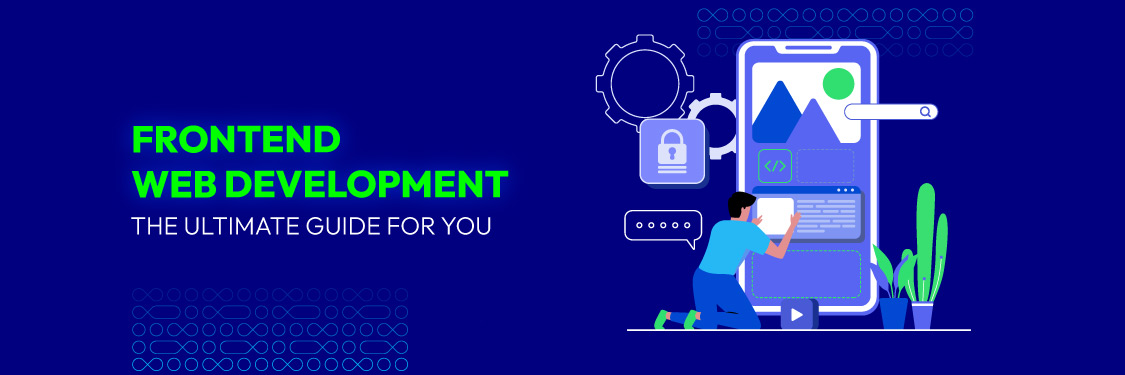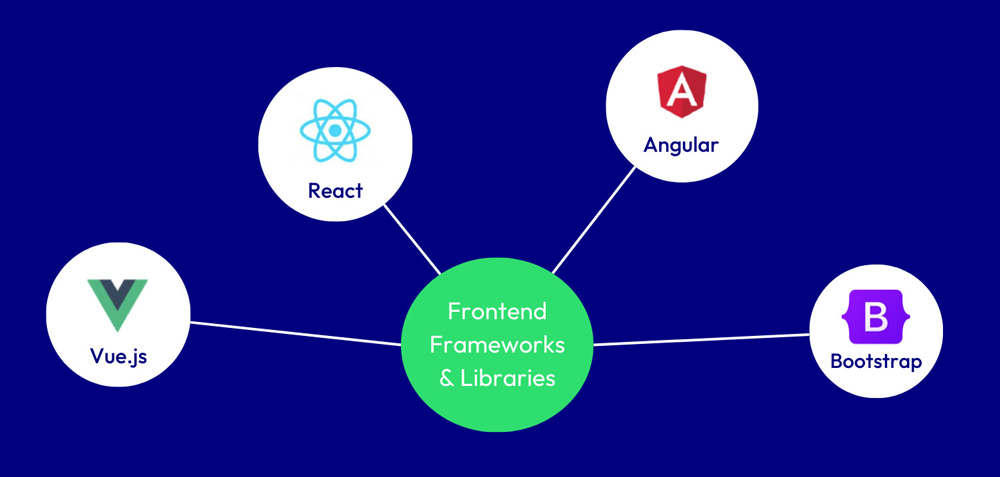Frontend Web Development: The Ultimate Guide for You
Summer Nguyen | 07-25-2024

Do you know how websites come to life with interactive menus, smooth animations, and visually stunning layouts? Frontend web development is the magic behind these captivating user experiences. It’s a dynamic field where creativity and technology intersect to create the interfaces we interact with everyday.
In this guide, we’ll journey through the world of frontend web development, exploring the roles of developers, the key components and inspiring examples that showcase the possibilities. Whether you’re a business owner, a developer, or simply a curious web user, this guide will equip you with the knowledge to craft exceptional digital experiences that leave a lasting impact.
Understanding Frontend Web Development
Frontend web development is about creating the parts of a website that users see and interact with directly.
Think of it as the “face” of the website, encompassing everything from the layout and colors to the buttons, menus, and interactive elements. Frontend developers use a combination of code (HTML, CSS, and JavaScript) and creative design skills to craft user interfaces (UIs) that are both visually appealing and easy to use.

Key elements of frontend web development:
- Visual Design: Using color, typography, and layout to create a visually appealing interface.
- User Interface (UI) Design: Crafting intuitive and user-friendly interactive elements like buttons and menus.
- Coding Languages: The building blocks for structuring, styling, and adding interactivity to websites.
- Responsive Design: Making sure websites adjust smoothly to various screen sizes and devices.
- Performance Optimization: Techniques to make websites load quickly and run smoothly.
Why Do We Need Frontend Web Development?
Frontend web development is crucial for creating a positive first impression and fostering a successful online presence. A well-designed frontend:
- Enhanced User Experience: 88% of online consumers won’t come back to a website after a bad experience. A good-looking and easy-to-use frontend is very important for turning visitors into buyers. For example, a clothing store with a clear way to find products will likely make more sales than one with a confusing layout.
Learn more: 15+ Best UX Design Websites for Inspirations
- Improved Brand Image: The frontend is often the first impression users have of your brand and 75% of people judge a brand’s trustworthiness based on how it looks. A professional layout increases your brand’s expertise and sets your business apart from the others.
- Better SEO: 68% of online interactions start with a search engine. A well-structured frontend with clean code and fast loading times improves SEO, boosting visibility in search results and driving organic traffic.

- Increased Conversion Rates: A user-friendly frontend encourages people to take action, like buying something or signing up. This leads to increased time on site, repeat visits, and higher conversion rates. For example, a travel agency website with an interactive map will generate more leads than one with only static content.
- Boosting Business Success: Focusing on great frontend design leads to real results, like happier customers, more leads, higher revenue, and a better edge over competitors.
Free 1-1 consultation: Website Development Service
- Frontend and backend development in one package
- Customized website tailored to your needs
- Lightning-fast onboarding in just 48 hours
- Free 2-month support after the project
Responsibilities of Frontend Developers
Frontend developers make websites and apps look good and work smoothly. They handle everything users see and interact with. Here are their main responsibilities:
- Building the User Interface (UI): Frontend developers turn design ideas into working web pages using HTML, CSS, and JavaScript.
- Ensuring The Compatibility: Frontend developers make sure that websites and applications work well on different browsers (Chrome, Firefox, Safari, etc.) and devices (desktops, tablets, phones).
- Optimizing for Performance and Accessibility: They work to make pages load quickly and ensure that content is accessible to everyone, including people with disabilities.
- Implementing Interactive Features: They use JavaScript (and often frameworks like React, Angular, or Vue.js) to add dynamic elements to websites, such as animations and interactive forms.
- Collaborating With Team Members: They collaborate with designers to meet visual and user needs and with backend developers to connect the frontend with server data.
Technologies for Frontend Web Development
Building a modern website is like constructing a house. You need a solid foundation, a stylish exterior, and functional systems that make it livable. In frontend web development, these roles are filled by three core technologies and several supporting tools.
Programming Languages
- HTML: Think of HTML as the framework of your house. It defines the structure of each room (or section of a webpage) and what goes inside (text, images, links, etc.).
- CSS: CSS is your interior designer. It determines the look and feel of your house – the colors, the furniture placement, and the overall aesthetic. It makes your website visually appealing and easy on the eyes.
- JavaScript: This is the electricity and plumbing of your website. JavaScript brings your house to life with interactive elements, animations, and functionality. It allows users to click buttons, submit forms, and experience a dynamic web page.
Learn more: JavaScript New Features: ECMAScript® 2024 (ES15) Updates
Frontend Frameworks and Libraries
Imagine having a set of pre-designed blueprints for your house that you can customize. Frontend frameworks and libraries like React, Angular, and Vue.js offer a similar advantage. They provide pre-built components and structures, making development faster and more efficient.
- React: This library is like a modular building system. It lets you create reusable components, which are like prefabricated rooms you can easily assemble and customize.
- Angular: A comprehensive framework that provides a complete structure for building complex web applications, similar to a detailed architectural plan for a mansion.
- Vue.js: Known for its flexibility and ease of use, Vue.js is like a versatile toolkit that allows you to tailor your website construction process to your specific needs.
- Bootstrap: This isn’t a framework like React, Angular, or Vue.js. Instead, it’s a CSS framework that offers pre-designed styles, elements, and a grid system to help create responsive websites that work well on all screen sizes and devices.

Package Managers
Just like a construction project needs a reliable supplier for materials, web development relies on package managers.
- npm (Node Package Manager): The default package manager for Node.js, used to install, manage, and share JavaScript libraries and tools.
- Yarn: An alternative package manager offering faster installation and improved security features.
Build Tools
Build tools are like the construction crew that assembles your house. Tools like Webpack and Parcel take your code, optimize it, and package it into a format that browsers can understand. They automate tasks like combining files, minifying code, and optimizing images, making your website faster and more efficient.
- Webpack: A powerful module bundler that combines multiple files and optimizes them for production environments.
- Parcel: A fast and zero-configuration bundler that simplifies the development workflow.
- Rollup: A module bundler focused on creating smaller, optimized bundles for libraries and applications.
Version Control Systems
- Git: The most widely used VCS, allowing developers to track changes, collaborate effectively, and revert to previous versions of code.
- GitHub, GitLab, Bitbucket: Popular platforms for hosting Git repositories and facilitating collaborative development.
By understanding these key components, you’ll gain a clearer picture of the frontend web development process and the tools that empower developers to create amazing digital experiences.
Learn About Responsive Web Development
Definition
In the ever-evolving landscape of frontend web development, responsive web development (RWD), also known as responsive design, has become a non-negotiable. RWD is an approach that allows a website to change the layout and features based on the size and shape of your device. So, whether you’re on a big computer screen or a small phone, the site will automatically change to give you the best view.
How to Achieve RWD?
Frontend developers employ a combination of techniques and tools to bring responsive websites to life:
- Flexible Grids: Instead of fixed-width layouts, grids divide the page into columns that adjust their width proportionally based on screen size. CSS Grid and Flexbox are powerful layout tools for creating flexible grids.
- Fluid Images: Images are set to scale automatically, ensuring they fit within their containers without distorting or overflowing.
- Media Queries: These CSS rules apply different styles depending on specific conditions, such as screen width, resolution, or orientation. Developers use media queries to create breakpoints, which are specific screen widths where the layout and content adjust.
- Mobile-First Approach: This design philosophy prioritizes building for smaller screens first and then progressively enhancing the design for larger screens. This ensures a solid foundation for mobile usability and simplifies the addition of styles for larger viewports.
- Responsive Typography: Font sizes are set in relative units (like percentages or ems) so they scale proportionally with the screen size.
- Responsive Navigation: Navigation menus are designed to adapt to different screen sizes, often collapsing into hamburger menus on smaller screens.
- Touch-Friendly Interactions: Buttons and links are made larger and easier to tap on touchscreens.
- Testing and Optimization: It’s important to test the website on many devices and screen sizes to make sure it works well for everyone.
By mastering these techniques, frontend developers can build websites that work well on any device, giving users a smooth experience no matter where they are.

Frontend Web Development FAQs
How do backend and frontend web development differ?
Frontend focuses on the user interface and visual aspects, while backend deals with server-side logic, databases, and functionality.
While this article touches on backend and frontend development, it doesn’t delve into their differences. For a comprehensive comparison, please see our article on the backend in web development.
How long does it take to develop the frontend of a website?
The development timeline varies greatly depending on several factors:
- Complexity of the Project: A simple site with just a few pages might be done in a few weeks, but a complex web app with interactive features could take several months.
- Number of Features and Functionality: More features and interactive elements naturally require more development time.
- Experience and Resources of the Development Team: A seasoned team with ample resources can work more efficiently than a smaller team with limited resources.
It’s important to talk with the development team about what you need so they can give you an accurate project cost.
What is the cost of hiring a frontend developer?
Prices change based on the complexity of the project, the developer’s experience, and the geographic location.
On Upwork, the hourly rates for hiring front-end developers typically range from $15 to $55, depending on experience:
| Experience Level | Hourly rates |
|---|---|
| Entry-level (Fresher) | $15 |
| Mid-level | $35 |
| Senior (Advanced) | $55 |
How do I maintain and update my website’s frontend after launch?
Frontend maintenance and updates are ongoing tasks:
- Content Updates: Regularly adding fresh content keeps your website relevant and engaging.
- Bug Fixes and Security Patches: Promptly addressing any technical issues or security vulnerabilities is crucial for website stability and user trust.
- Technology Upgrades: Keeping your frontend code and libraries up-to-date ensures compatibility with new browsers and devices.
- Design Refresh: Periodically updating the design helps keep your website looking modern and appealing.
Many businesses opt for ongoing maintenance contracts with development teams to ensure their frontend stays in top shape.
Final Thoughts
The frontend of your website is your digital storefront. It’s frequently the first impression customers get of your brand. Don’t leave this to chance. Take the time to understand the nuances of frontend development, partner with skilled professionals, and unlock the full potential of your online presence.
Whether you’re a small business owner or a large enterprise, investing in top-notch front-end development isn’t just an option; it’s a strategic necessity in today’s digital landscape.








